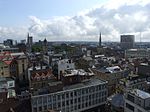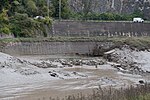Sack Friary, Bristol
Sack Friary, Bristol was a friary in Bristol, England. It was established in 1266 and dissolved in 1286.The mendicant religious order was known as the Friars of the Sack and the Brothers of Penitence. The friars first appeared in England in 1257, with the order apparently originating in Italy, where they were known as "Fratres de Sacco". The order began in 1251 and expanded into Britain, France, Spain, Germany and Palestine. The Second Council of Lyon took up the question of limiting mendicant religious orders. In 1274, the four major orders-the Franciscans, the Dominicans, the Carmelites and the Austin Friars were allowed to remain with the lesser orders instructed to disband.The first mention of the order in Bristol was circa 1266 when Henry III of England granted the friars six oaks from Selwood Forest for building. Records of the 1287 Pleas of the Crown establish that there was a house of Friars of the Sack before that time, but no one is certain where it was located. The last mention of the order in Bristol is found on a document dated October 31, 1322. The document refers to a tenement outside Bristol Temple Gate located near the church of the "Friars di saccis" signed by Simon de Ely, burgess of Bristol to William de Cameleigh.
Excerpt from the Wikipedia article Sack Friary, Bristol (License: CC BY-SA 3.0, Authors).Sack Friary, Bristol
Bridge Street, Bristol Broadmead
Geographical coordinates (GPS) Address Nearby Places Show on map
Geographical coordinates (GPS)
| Latitude | Longitude |
|---|---|
| N 51.4542 ° | E -2.5913 ° |
Address
Bridge Street
Bridge Street
BS1 2AW Bristol, Broadmead
England, United Kingdom
Open on Google Maps









